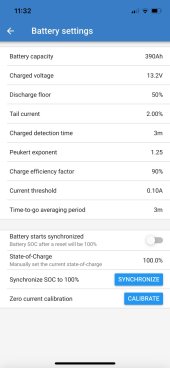slowbutsure
New Member
- Joined
- Apr 21, 2022
- Messages
- 189
Hi
I have just installed a Victron Smart Shunt. I have 3 130ah batteries in parallel using two bus bars to connect them. The Victron Shunt says the voltage is 12.5, a multimeter says 12.4, I also have an Automatic Transfer switch which says 12.3! All are directly connected / tested at the battery terminals. I dont know which one is right! It is important as I have to set the voltage at which the Automatic switch changes over to grid power. If changes too soon it defeats the object, if too late it could damage the batteries.
The Smart Shunt is now saying 12.4 % and saying its 98% charged. Im not sure how 12.4% could be 98% charged? But they were fully charged when I connected the shunt.
Any help appreciated. thanks.
Trevor
I have just installed a Victron Smart Shunt. I have 3 130ah batteries in parallel using two bus bars to connect them. The Victron Shunt says the voltage is 12.5, a multimeter says 12.4, I also have an Automatic Transfer switch which says 12.3! All are directly connected / tested at the battery terminals. I dont know which one is right! It is important as I have to set the voltage at which the Automatic switch changes over to grid power. If changes too soon it defeats the object, if too late it could damage the batteries.
The Smart Shunt is now saying 12.4 % and saying its 98% charged. Im not sure how 12.4% could be 98% charged? But they were fully charged when I connected the shunt.
Any help appreciated. thanks.
Trevor




